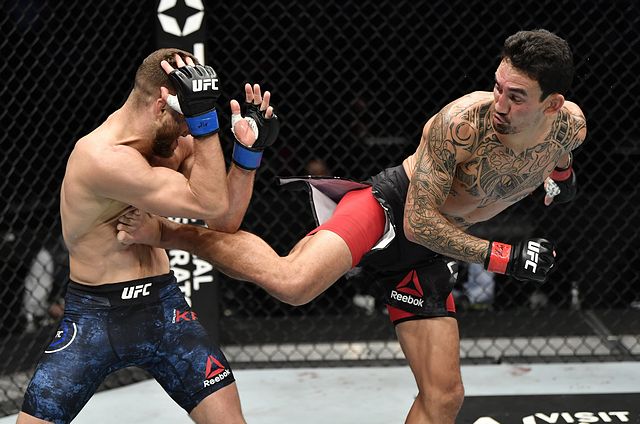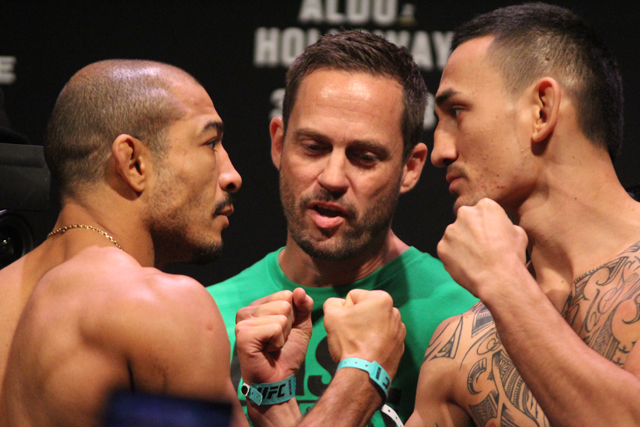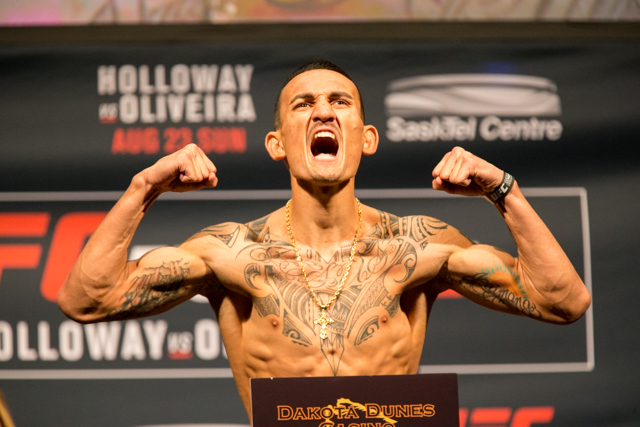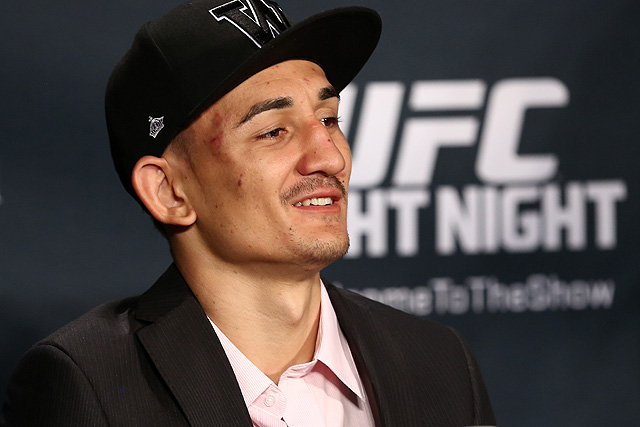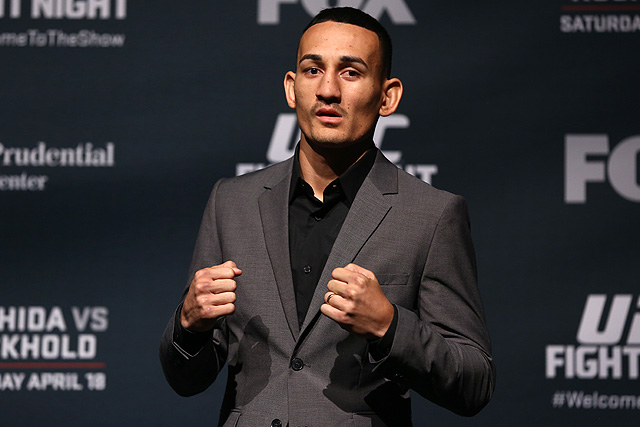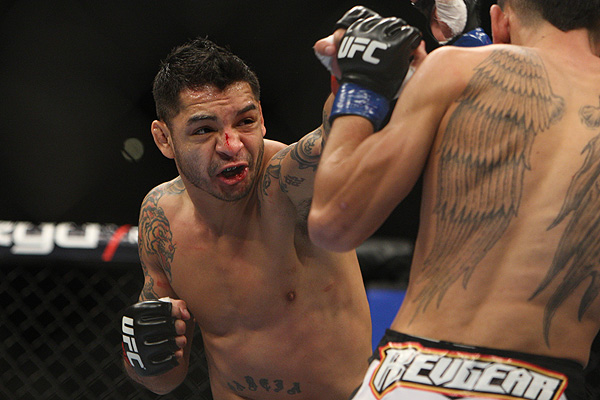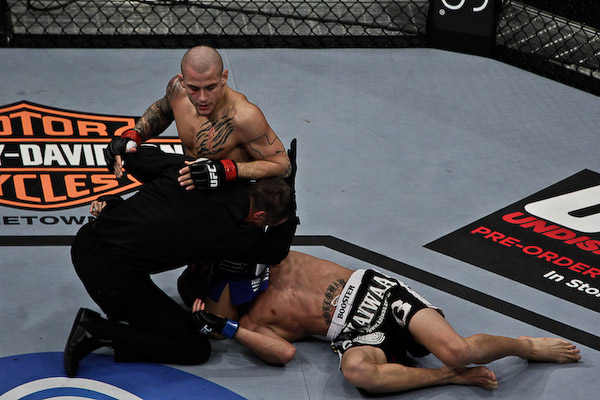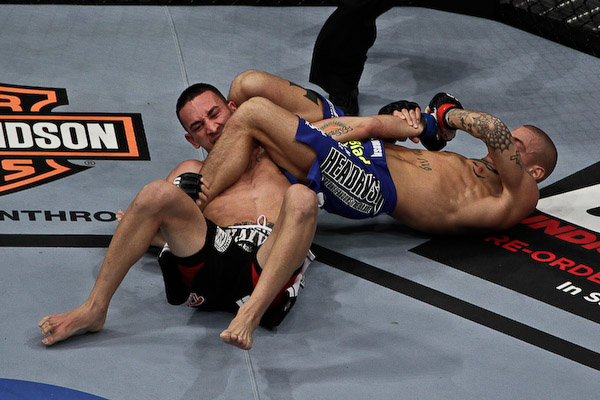A Feature, Not a Bug
Editor’s note: The views and opinions expressed below are those of the author and do not necessarily reflect the views of Sherdog.com, its affiliates and sponsors or its parent company, Evolve Media.
For a sport which requires its competitors to dehydrate themselves to the point of organ failure before entering a cage to punch and kick each other in the head for 15 to 25 minutes, it has always struck me as odd how willing we are to attribute injuries and other afflictions to supernatural forces. Over the weekend, however, that’s exactly how a large section of the media and fan base reacted to the news of Max Holloway’s withdrawal from the UFC 226 co-main event title defense due to concussion like symptoms.
Advertisement
For his part, Ultimate Fighting Championship President Dana White seemed resigned to the inevitability of casualties like Holloway’s. When asked at the pre-fight press conference whether the UFC would consider reviewing its procedures to better ensure its athletes were able to make it to fight day in a healthy condition, he responded in typically obstinate fashion: “It’s impossible. You’re dealing with human beings. It happens, [and] there’s nothing you can do. We’ve done everything you can possibly do to make these guys healthier.”
It’s true that the UFC does more than most promotions to monitor
athletes on fight week, and the
vaunted UFC Performance Institute has made a difference for
many on the organization’s roster. However, it demonstrates a
breathtaking lack of self-awareness -- or just plain old-fashioned
dishonesty -- to suggest that’s where the buck stops. The general
aversion of the fans and media to scrutinize the structural causes
of the company’s increasingly abysmal track record when it comes to
fighter health and instead attribute it to the winds of fate, even
when uttered tongue in cheek, is equally frustrating.
It is after all the UFC which rewards fighters for engaging in fights that generate the most head trauma: $50,000 “Fight of the Night” bonuses typically go to the fighters who “stand and bang” at the expense of more tactical battles, this while world-class fighters with grappling-centric styles -- take Jon Fitch or Ben Askren -- are told to take their talents elsewhere. In “sports entertainment,” it’s the entertainment that’s king, and that comes at an undeniable physical cost.
The UFC and White also lionize athletes who “push through” and fight injured, while questioning the heart of those who prioritize their health over competition. Such a theme was at the heart of the second season of “The Ultimate Fighter” -- the “trojan horse” that vaulted MMA into the mainstream consciousness and informed many fans’ and fighters’ perception of both the sport and what should be expected of its competitors. Week after week, White reprimanded contestants whose bodies failed them. Kenny Stevens was a guy who “pussed out” after his attempts to cut 20 pounds in 24 hours ended in his suffering dizziness, double vision and vomiting; Rob McDonald was criticized for speaking up about a shoulder injury because it apparently demonstrated his lack of mental fortitude; fighters who erred to engage in hard sparring were eviscerated for “not wanting it enough.”
Back then, the UFC was “fighting for acceptance” and had -- according to company lore -- only just begun turning a profit. Today, it’s a multi-billion-dollar entertainment conglomerate that waxes lyrical about being an advocate for athletes’ long-term health and safety. However, when push comes to shove, the same message that permeated the early days of the Zuffa era resounds, and the examples where it has manifested are endless.
Remember when Cristiane Justino was admitted to the hospital due to serious dehydration and depression after a series of life-threatening weight cuts? White tried to bully her into taking a fight at UFC 208 and then disparaged her in the media when she refused. Remember when former heavyweight champion Cain Velasquez admitted to experiencing serious back pain in advance of his rematch with Fabricio Werdum at UFC 207? White told anyone who would listen that Velasquez gave the interview because he didn’t want to fight. Remember when featherweight champion Jose Aldo withdrew from his scheduled title defense against Conor McGregor at UFC 189 due to a fractured rib? White publicly accused him of overstating the injury to avoid a difficult weight cut. The list goes on.
Those are just the fighters at the top of the bill. Look lower down the card, and you’ll see the same insouciant attitude towards fighter health play out on a much larger scale against a backdrop of crushing economic insecurity.
Take the UFC’s pitiful median payout -- inclusive of bonuses and side deals -- to fighters in 2016, which Bloody Elbow’s John Nash estimates to be $30,000 per bout. For fighters on the prelims, the sum is only $19,000, and that’s before subtracting deductions for tax, training and management. As pointed out by the likes of UFC featherweight Myles Jury, many fighters are actually losing money competing in the sport’s premier organization, making additional expenses, like hiring a nutritionist for their weight cut or getting specialized recovery for injuries that aren’t covered by the UFC’s health plan, essentially implausible.
Sure, the UFC Performance Institute might be an option for fighters who live in Nevada, but for the 90-plus percent of fighters on the UFC roster who don’t, that’s rendered moot by the prohibitive costs of travel and accommodation. As the sport evolves then, with more taxing forms of training and more sophisticated forms of recovery, the gap between what is expected of athletes at the highest level and what they can afford only gets wider. Injuries, makeshift solutions and long-term health problems are an inevitable result.
The UFC’s habit of signing young prospect at the eleventh hour due to late withdrawals is also fundamentally inconsistent with a commitment to fighter health and safety. Studies have already shown that MMA fighters lose a significantly greater magnitude of weight compared to athletes in other combat sports, but undertaking a cut on short notice is even more precarious. Just three events ago, Craig White ahead of his promotional debut cut a death-defying 46 pounds in two weeks to compete at UFC Fight Night 130; it was the same card where headliner Darren Till, a top welterweight contender, reportedly went blind trying to cut a similarly outrageous amount of weight.
The UFC knows fighters will undertake serious physical risks for the opportunity to compete at the big show and makes it clear to them that failure to make it to fight day is not an option. Andrew Todhunter was in a similar position to Craig White in 2015 when he was offered a late-notice bout against Albert Tumenov at UFC 188. After he fainted during an attempt to cut 30 pounds in less than two weeks, he was declared medically unfit to compete and the fight was scrapped. Apparently so was his UFC contract. Todhunter never debuted with the organization and took his next bout in the Legacy Fighting Championship.
None of this is to deny the fact that injuries in MMA are an inevitable feature of the sport or to suggest that the UFC is the only entity responsible for this state of affairs. Rather, it’s an invitation to have a more honest discourse about cause and effect.
The UFC places enormous pressure on its athletes to fit into its consistently stacked event calendar, requires them to do a full week of media, open workouts and promotion as a condition precedent to their meager “Reebok pay,” pays them a pittance and refuses to even pay their show money when their opponent withdraws or misses weight. Already among the most driven and intrepid athletes on the planet, fighters are then placed into a position to take even greater risks with their health due to financial and reputational reasons. The UFC scoffs at reforms that don’t align with its commercial interests -- take the introduction of new weight classes, for example -- and fighters who indicate they need to move up a division are not infrequently pressured to stay put if that contradicts the promotion’s long-term strategy.
As long as everything I’ve just set out remains the status quo, then the rate of injuries, fighters’ missing weight and last-minute withdraws isn’t going to change. If anything, it will get worse. That has nothing to do with fate.
Jacob Debets is a recent law graduate who lives in Melbourne, Australia. He has been an MMA fan for more than a decade and trains in muay Thai and boxing at DMDs MMA in Brunswick. His work has been published widely, including on Fight News Australia, LawinSports, LowKickMMA, MMASucka De Minimis and Farrago. He is currently writing a book analyzing the economics and politics of the MMA Industry. You can view more of his writing at jacobdebets.com.
Related Articles





























































































































































































































































































